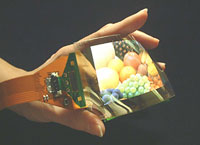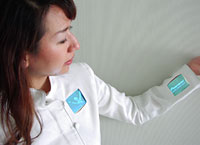|
|
|||||||
|
|
|||||||
|
|||||||
| | Web Japan >> | Trends in Japan >> | Business & Economy >> | Bright Future | |
|
BRIGHT FUTURE Organic Electroluminescence Opens New Possibilities (August 6, 2003) Most televisions and computer monitors use cathode ray tubes or liquid-crystal displays. The use of LCDs has become quite widespread in recent years, as they can be made slim and are therefore not as bulky as CRTs. Except for plasma displays, the most promising candidate to succeed LCDs as the next generation of display-panel technology is organic electroluminescence, which holds the promise of bendable screens and crystal-clear images, perhaps even enabling the creation of wearable display panels. Competition among Japanese makers to develop and manufacture organic EL displays is intensifying.
Clear Images from Any Angle Drawing on their past experiences with semiconductors and liquid-crystal displays, Japanese companies are looking to take the lead in the development of this next generation of display panels in terms of manufacturing technology and equipment. Organic EL panels are made from a form of organic material that emits light when an electric current is applied to it. While LCDs emit light from behind the screen, with organic EL, it is the screen itself that emits the light, meaning that a clear image can be seen from any angle. In addition, organic EL panels are thin and can be made lightweight. Some digital cameras, car-stereo systems, and mobile phones with organic EL screens have already hit the shops. Organic EL TVs are likely to be commercially available in 2005. It is possible to roll organic EL screens up like a piece of paper, and some researchers have devised a number of interesting potential applications, such as weaving a wearable TV screen into clothing. Eastman Kodak developed the basic technology for organic EL in the late 1980s. Tohoku Pioneer Corp. then became the first company to produce multicolor organic EL displays in 1999. While the scale of the organic EL market in 2002 was only about $80 million, the US research firm DisplaySearch expects it to grow to $3.6 billion by 2005. Though small in comparison with the market for LCDs, which was about $25 billion in 2002, there are hopes that the market for organic EL will expand dramatically when prices fall and the number of applications for the technology increases. The panel created by Sanyo and Kodak is made of glass and measures 2.16 inches diagonally. While it consumes slightly more electricity than current LCD panels, the picture it produces is five times crisper in terms of brightness and contrast. The display panel is just 1.8 millimeters thick, about half the thickness of an LCD. SK Display Corp., a joint venture between the two companies, is producing enough organic EL paneling every month to make 100,000 two-inch panels. Monthly production will increase by 1 million units when Tottori Sanyo Electric Co. begins manufacturing the panels this year.
Wearable TVs Expected The film-like organic EL prototype developed by Pioneer, meanwhile, is 4.7 centimeters high, 6.2 centimeters wide, and 0.2 millimeters thick - about the size of a train pass - and weighs just 3 grams. Another difference between this type of panel and a glass one is that it will not break or crack when it is dropped, a condition that should allow a variety of new uses. Pioneer, for example, is studying the idea of weaving displays into clothing to create "cyberwear." And because organic EL film is transparent, its use is being considered for placing car-navigation display panels directly on car windshields and also for electronic newspapers. This flexible, high-resolution screen material promises to open up a whole new range of possibilities for consumers in the years to come. Related Web SitesEastman Kodak Co. Sanyo Electric Co. Pioneer Corp. Hitachi Sony Corp. Toshiba Corp. Tohoku Pioneer Corp. (Japanese only) Tottori Sanyo Electric Co. Toshiba Matsushita Display Technology Co. Copyright (c) 2004 Web Japan. Edited by Japan Echo Inc. based on domestic Japanese news sources. Articles presented here are offered for reference purposes and do not necessarily represent the policy or views of the Japanese Government. |
PICTURE-PERFECT PLASMA (March 19, 2003) A NEW DIMENSION (November 27, 2002) |
|
|




